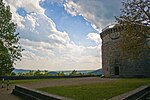Frauenroth Abbey
Buildings and structures in Bad Kissingen (district)Cistercian nunneries in GermanyMonasteries in Bavaria

Frauenroth Abbey is a former Cistercian nunnery in Burkardroth in Bavaria, South Germany, in the bishopric of Würzburg The abbey, dedicated to Saint George and All Saints, was built in 1231 by Count Otto von Botenlauben and Beatrix de Courtenay, who were both later buried here. Following their deaths, their son, also called Otto, became head of the abbey. The abbey ceased was dissolved in 1574, and was taken over by the administrative office of the Prince-Bishop of Würzburg. In 1691, the remains were sold to eight farmers in Burkardroth, who used them to build the village of Frauenroth. The former monastic chapel still stands and is used as a church.
Excerpt from the Wikipedia article Frauenroth Abbey (License: CC BY-SA 3.0, Authors, Images).Frauenroth Abbey
An der Klostermauer,
Geographical coordinates (GPS) Address Website External links Nearby Places Show on map
Geographical coordinates (GPS)
| Latitude | Longitude |
|---|---|
| N 50.261388888889 ° | E 10.018611111111 ° |
Address
Klosterkirche Frauenroth
An der Klostermauer
97705
Bavaria, Germany
Open on Google Maps









